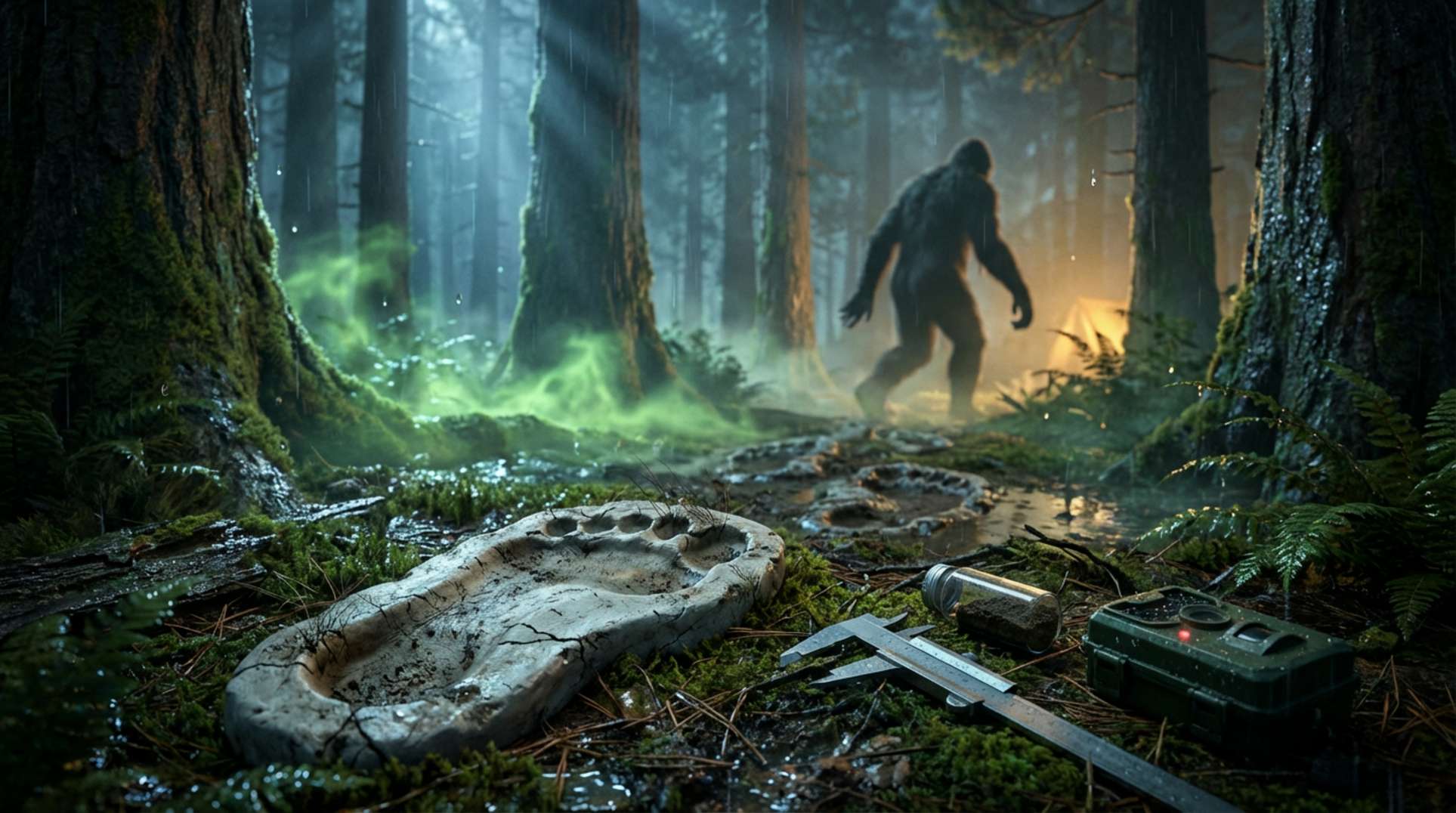For years, people have been fascinated by the mystery of Bigfoot. From ancient legends to modern-day sightings, stories of this elusive creature have captured our imaginations. Despite numerous investigations and countless hours of research, the truth about Bigfoot remains a mystery. Are we any closer to uncovering the truth?
Key Takeaways
- Bigfoot has been part of human folklore for centuries, with stories from Native American legends to modern encounters.
- Scientific investigations, including DNA analysis and footprint evidence, have yet to provide conclusive proof of Bigfoot’s existence.
- Numerous hoaxes have muddied the waters, making it difficult to separate fact from fiction.
- Bigfoot has a significant presence in popular culture, featuring in movies, TV shows, books, and merchandise.
- Theories about Bigfoot’s existence range from it being a surviving prehistoric ape to an interdimensional being.
Historical Bigfoot Sightings
Early Native American Legends
Native American tribes have long spoken of a mysterious creature roaming the forests. Known by various names, these legends describe a large, hairy being that is both feared and respected. The stories often depict Bigfoot as a guardian of the forest, a creature that lives in harmony with nature.
Pioneer Accounts
As settlers moved westward, tales of Bigfoot sightings began to emerge. Pioneers reported encounters with a large, hairy creature that walked on two legs. These early accounts often described the creature as having a foul odor and deep-set eyes. One notable sighting occurred in 1978 in Ottosen, Iowa, where multiple witnesses, including children, claimed to see a "short, hairy, ape-like animal."
Modern-Day Encounters
In recent years, Bigfoot sightings have continued to capture the public’s imagination. From the dense forests of the Pacific Northwest to the rolling hills of Jefferson County, people have reported seeing a hairy, bear-like animal with glowing eyes. Despite numerous sightings and extensive searches, the elusive Bigfoot remains a mystery, vanishing into the shadows as quickly as it appears.
The legend of Bigfoot, also commonly referred to as Sasquatch, continues to intrigue and mystify people around the world.
Scientific Investigations into Bigfoot
DNA Analysis
Scientists have tried to uncover the truth about Bigfoot through DNA analysis. Hair samples, often thought to belong to Bigfoot, have been tested. However, most results show they come from common animals like deer or bears. Despite these findings, some researchers believe that science hasn’t yet caught up with the mystery of Bigfoot.
Footprint Evidence
Footprints are one of the most common pieces of evidence in Bigfoot investigations. These prints are often large and human-like but with some differences. Experts use plaster casts to preserve these prints for further study. While some footprints have been proven to be hoaxes, others remain unexplained, keeping the debate alive.
Audio Recordings
Audio recordings of howls and other strange sounds in the wilderness are also used as evidence. Some recordings have been analyzed and found to be heavily edited, creating hoaxes. However, there are cases of unexplained howls that experts have not ruled out as being Bigfoot calls. Shows like Ground Zero with Clyde Lewis often discuss these intriguing audio clips, adding to the ongoing mystery.
The search for Bigfoot continues, driven by the hope that one day, science will uncover the truth behind this elusive creature.
Debunking Bigfoot Hoaxes
Famous Hoaxes
Over the years, many Bigfoot sightings have been exposed as hoaxes. One of the most famous cases is the 1967 Patterson-Gimlin film, which some experts believe shows a man in a costume. Another well-known hoax involved a frozen Bigfoot body that turned out to be a rubber suit filled with animal parts.
Techniques Used to Create Hoaxes
Hoaxers often use various techniques to create fake Bigfoot evidence. These include:
- Costumes: People dress up in gorilla suits or other costumes to mimic Bigfoot.
- Footprint molds: Fake footprints are made using molds to leave tracks in the wilderness.
- Edited audio recordings: Some hoaxers manipulate sounds to create fake Bigfoot calls.
Impact on Public Perception
Hoaxes have a significant impact on how the public views Bigfoot sightings. They create skepticism and make it harder for genuine sightings to be taken seriously. Shows like Ground Zero Radio often discuss these hoaxes, further fueling public doubt.
The repeated exposure to hoaxes can make people dismiss all Bigfoot sightings as fake, even when there might be some truth to the claims.
Bigfoot in Popular Culture
Movies and TV Shows
Bigfoot has been a staple in movies and TV shows for decades. From the classic film "Harry and the Hendersons" to the more recent "Bigfoot Family," the creature has captured the imagination of audiences. TV shows like "Finding Bigfoot" have also contributed to the legend, with teams of investigators searching for evidence of the elusive creature. Bigfoot’s presence in media has helped keep the legend alive and thriving.
Books and Comics
The legend of Bigfoot extends beyond the screen and into the pages of books and comics. Titles like "Sasquatch: Legend Meets Science" and the graphic novel "Bigfoot: Sword of the Earthman" explore various aspects of the creature’s mythology. These works often blend scientific inquiry with imaginative storytelling, offering readers a diverse range of perspectives on Bigfoot.
Merchandising
Bigfoot’s popularity has also led to a wide array of merchandise. From T-shirts and mugs to action figures and board games, the creature’s image is used to sell a variety of products. One notable example is the "Bigfoot In The Woods T-Shirt," which features an iconic image of Bigfoot walking through the forest. This merchandising not only capitalizes on Bigfoot’s fame but also helps to perpetuate the legend in everyday life.
Bigfoot’s influence in popular culture is undeniable, serving as a bridge between folklore and modern entertainment. The creature’s enduring presence in various media forms keeps the mystery alive and continues to captivate new generations.
Theories About Bigfoot’s Existence

Surviving Gigantopithecus
One popular theory suggests that Bigfoot could be a surviving Gigantopithecus, a giant ape species thought to have gone extinct thousands of years ago. Proponents of this idea argue that the dense forests and remote areas where Bigfoot is often reported could provide the perfect hiding spots for such a creature. Despite the lack of concrete evidence, this theory remains a favorite among those who believe in Bigfoot’s existence.
Extraterrestrial Theories
Another intriguing theory is that Bigfoot might be an extraterrestrial being. Some people believe that the creature’s elusive nature and the strange phenomena often reported during sightings, such as unexplained lights in the sky, suggest a connection to aliens. This theory, while more speculative, adds an extra layer of mystery to the Bigfoot legend.
Interdimensional Being
A more outlandish theory posits that Bigfoot could be an interdimensional being, capable of moving between our world and another dimension. This would explain why the creature is so hard to track and why physical evidence is so scarce. While this idea stretches the imagination, it highlights the lengths to which some will go to explain the enduring mystery of Bigfoot.
Bigfoot Sightings Around the World
North America
In North America, Bigfoot, also known as Sasquatch, is a large, hairy, humanlike creature believed by some to exist in the northwestern United States and western Canada. Numerous sightings have been reported over the years, with some even captured on video. The dense forests and vast wilderness areas provide the perfect hiding spots for such an elusive creature.
Asia
Asia has its own version of Bigfoot, often referred to as the Yeti or the Abominable Snowman. Sightings are mostly reported in the Himalayan regions of Nepal, Bhutan, and Tibet. The Yeti is described as a large, ape-like creature that roams the snowy mountains. Despite many expeditions, concrete evidence remains elusive.
Australia
In Australia, the creature similar to Bigfoot is known as the Yowie. Sightings have been reported in the eastern parts of the country, particularly in the dense forests of Queensland and New South Wales. The Yowie is described as a tall, hairy creature with a distinct odor. While some believe in its existence, others think it might be a case of mistaken identity or folklore.
Eyewitness Accounts of Bigfoot

Personal Testimonies
Eyewitness accounts of Bigfoot are often the most compelling pieces of evidence for believers. These stories come from people of all walks of life, from hikers and hunters to everyday folks who claim to have had a close encounter with the elusive creature. One of the most famous testimonies comes from Roger Patterson and Bob Gimlin, who filmed what they believed to be Bigfoot in 1967. Their footage, known as the Patterson-Gimlin film, remains one of the most debated pieces of evidence to this day.
Video and Photographic Evidence
Over the years, numerous videos and photographs have surfaced, claiming to show Bigfoot. Some of these are blurry and inconclusive, while others have been analyzed extensively. For instance, the Patterson-Gimlin film has been scrutinized by experts and skeptics alike. Shows like Ground Zero with Clyde Lewis often feature discussions on the latest Bigfoot sightings and the authenticity of these visual pieces of evidence.
Skeptical Perspectives
Skeptics argue that eyewitness accounts are unreliable and that many videos and photos can be easily faked. They point out that human perception is flawed and that people can mistake bears or other animals for Bigfoot. Additionally, the history of Bigfoot research is filled with hoaxes and misidentifications, making it hard to separate fact from fiction. Despite this, the allure of Bigfoot continues to captivate the public’s imagination.
The Role of Technology in Bigfoot Research
Drones and Thermal Imaging
Drones have become a game-changer in the search for Bigfoot. They can cover large areas quickly and access remote locations that are difficult for humans to reach. Thermal imaging technology, often attached to these drones, helps detect heat signatures of living creatures, making it easier to spot Bigfoot in dense forests or during nighttime.
Motion-Activated Cameras
Motion-activated cameras, also known as trail cams, are widely used by researchers. These cameras are set up in areas with frequent Bigfoot sightings and can capture images or videos when movement is detected. This method has provided some intriguing footage, though none have been conclusive.
Crowdsourced Data
Crowdsourcing has opened new avenues for Bigfoot research. Platforms like Ground Zero Radio encourage people to report sightings and share evidence. This collective effort helps researchers identify patterns and hotspots for Bigfoot activity. Crowdsourced data can be invaluable in narrowing down search areas and validating sightings.
The use of advanced technology in Bigfoot research not only enhances our ability to gather evidence but also brings us closer to uncovering the truth about this elusive creature.
Cultural Impact of Bigfoot
Tourism and Local Economies
Bigfoot has become a significant draw for tourists, boosting local economies in areas known for sightings. Towns like Willow Creek in California and Whitehall in New York have embraced their Bigfoot heritage, hosting festivals and opening museums. These events attract thousands of visitors each year, eager to explore the mystery and spend money on local businesses.
Bigfoot Festivals
Bigfoot festivals are a major part of the cultural landscape in many regions. These festivals feature guest speakers, merchandise, and even guided tours of supposed Bigfoot hotspots. They provide a platform for enthusiasts to share stories and theories, fostering a sense of community among believers and skeptics alike.
Community Beliefs and Traditions
In many communities, Bigfoot is more than just a legend; it’s a part of local tradition. Stories of encounters are passed down through generations, becoming a cultural touchstone. These tales often reflect the values and fears of the community, adding a layer of depth to the Bigfoot phenomenon.
The legend of Bigfoot invites us to look closer, question more, and keep exploring. It’s not just about the answers; it’s about the thrill of the chase and the stories that bind us.
Bigfoot and Environmental Conservation
Habitat Preservation
The search for Bigfoot often leads researchers into remote and pristine wilderness areas. These habitats are crucial not only for the potential existence of Bigfoot but also for countless other species. Protecting these areas ensures that they remain untouched by human development, preserving biodiversity and natural beauty.
Impact on Wildlife
The presence of Bigfoot, whether real or imagined, has sparked interest in the ecosystems where sightings occur. This attention can lead to increased efforts to study and protect local wildlife. For example, the show Ground Zero: Aftermath has highlighted how Bigfoot research can bring awareness to endangered species and their habitats.
Conservation Efforts
Many Bigfoot enthusiasts and researchers advocate for the conservation of forests and wilderness areas. They argue that preserving these environments is essential for the potential discovery of Bigfoot and the protection of our planet’s natural resources. This movement often collaborates with environmental organizations to promote sustainable practices and habitat conservation.
The quest to find Bigfoot is more than just a search for a mythical creature; it’s a call to protect the wild places that make our world unique.
Psychological Aspects of Bigfoot Belief

Cognitive Biases
Belief in Bigfoot can be influenced by various cognitive biases. Confirmation bias is a key factor, where individuals tend to favor information that confirms their pre-existing beliefs. For instance, someone who believes in Bigfoot might interpret ambiguous sounds in the forest as evidence of the creature’s existence. Another bias at play is the availability heuristic, where people judge the likelihood of Bigfoot encounters based on how easily they can recall related stories or media portrayals.
Social Influences
Social dynamics play a significant role in shaping Bigfoot beliefs. Communities and groups often form around shared interests in Bigfoot, creating a sense of belonging and identity. These groups might engage in activities like expeditions, meetings, and online discussions. Shows like "Ground Zero: Aftermath" provide platforms for enthusiasts to share their experiences and theories, further reinforcing their beliefs.
Emotional Impact
The emotional aspect of believing in Bigfoot cannot be overlooked. For many, the idea of an undiscovered creature roaming the forests is thrilling and adds a sense of wonder to their lives. This belief can also provide comfort, offering an escape from the mundane aspects of daily life. On the flip side, skeptics might experience frustration or disbelief when confronted with Bigfoot claims, leading to heated debates and discussions.
The belief in Bigfoot serves as a mirror, reflecting our deepest hopes, fears, and aspirations. It challenges us to think beyond the ordinary and consider the mysteries that still exist in our world.
Conclusion
The mystery of Bigfoot remains as elusive as ever. Despite numerous sightings and countless investigations, we still lack concrete evidence to prove the creature’s existence. Yet, this doesn’t stop people from searching and believing. The legend of Bigfoot continues to captivate our imaginations, driving us to explore the unknown and question what we think we know. Whether Bigfoot is a real creature hiding in the forests or simply a myth, the search itself speaks to our innate curiosity and desire for discovery. As technology advances and new methods of investigation emerge, who knows what we might uncover? Until then, the legend of Bigfoot will remain a fascinating enigma, inviting us to keep looking and never stop wondering.
Frequently Asked Questions
What is Bigfoot?
Bigfoot, also known as Sasquatch, is a legendary creature said to inhabit forests, mainly in the Pacific Northwest region of North America. Descriptions often depict it as a large, hairy, bipedal humanoid.
Are there any confirmed sightings of Bigfoot?
While many people have reported seeing Bigfoot, there is no scientifically confirmed evidence to prove its existence. Most sightings are anecdotal and lack verifiable proof.
What kind of evidence exists for Bigfoot?
Evidence for Bigfoot includes eyewitness accounts, blurry photos and videos, footprints, and audio recordings of strange sounds. However, none of this evidence has been conclusively proven to be from Bigfoot.
Have any scientific studies been conducted on Bigfoot?
Yes, some researchers have conducted studies, including DNA analysis of hair samples and examinations of footprints. Despite these efforts, no conclusive evidence has been found to support the existence of Bigfoot.
Why do people believe in Bigfoot?
People believe in Bigfoot for various reasons, including personal experiences, cultural stories, and the allure of the unknown. The mystery and possibility of discovering a new species also fuel interest.
Could Bigfoot sightings be hoaxes?
Yes, many Bigfoot sightings and pieces of evidence have been proven to be hoaxes. People have faked footprints, photos, and videos to perpetuate the legend.
What should I do if I think I saw Bigfoot?
If you believe you’ve seen Bigfoot, try to document your experience with photos or videos and report it to local authorities or Bigfoot research organizations. They can help investigate and verify your sighting.
How does Bigfoot impact popular culture?
Bigfoot has had a significant impact on popular culture, inspiring movies, TV shows, books, and merchandise. The creature is a symbol of mystery and the unknown, captivating public imagination.




